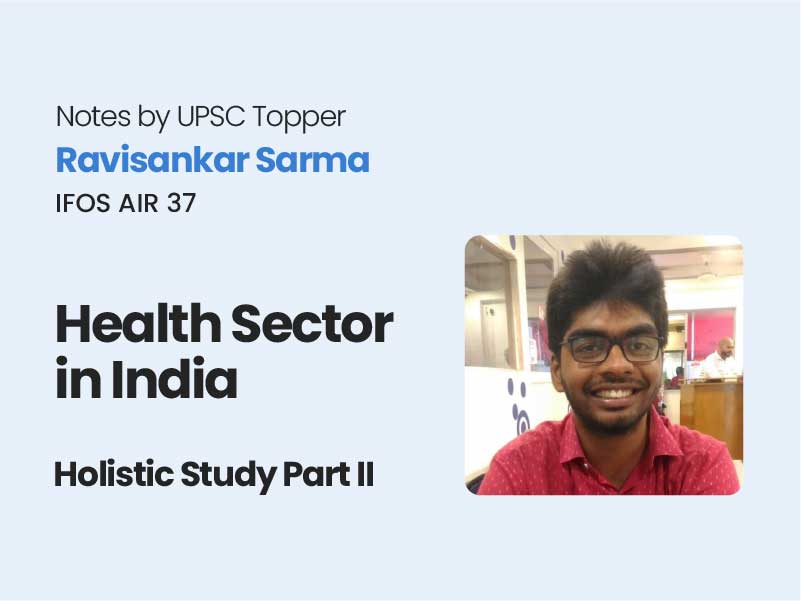Companion@360 → 7 Month programme to sharpen your writing skills → REGISTER NOW

Privatisation Of Health Sector
Introduction
The increased role of the private sector in the Health sector has raised a concern whether India is moving from the UK based patient-centric model to the American insurance-driven health delivery system. A careful analysis of the privatization of healthcare is needed to elucidate its ramifications.
The recent NHP, 2017 lays emphasis on systemic strengthening and strategic engagement with the private sector to comprehensively improve health service delivery in the country.
Why necessity?
Lack of public investment in the health sector means there is a huge demand-supply mismatch with regard to the provision of healthcare services. Partnerships with private sector entities enable quality screening, diagnosis, treatment services accessibility to patients with better infrastructure and technical expertise
NITI Aayog Guidelines
Co-habitation of private sector entities engaged in the provision of such services within public hospitals to provide specialized healthcare and treatment for cardiovascular, pulmonary diseases and cancer
Conditions for entering into PPP – State government
- Must accommodate a minimum number of state referred patients who are eligible to avail NCD services for cashless treatment of their ailments (To avoid commercialisation)
- In selecting public hospitals, a criteria of minimum patient strength and bed strength needs to be followed so that hospitals with largest inflow of patients gain most from partnerships
- Minimum services to be offered – IPD, OPD, Emergency services, critical care
- State governments need to leverage national and state initiatives and schemes for maximizing potential of privatisation – RSBY and NHPS
Benefits of Privatization
- Access to Specialized Healthcare: PPP model would improve accessibility to specialized health care in terms of human expertise, technology and equipment
- Enhance Infrastructural Quality: PPP model would provide a mechanism for private sector to engage with the public utilising government facilities and infrastructure of district hospitals. A viability gap funding by the state government needs to be set up for this.
- Economies of Scale: Private parties would share ambulance services, mortuary services and blood banks with the district hospitals while public hospitals benefit from superior quality of human resources as well as increased capital of private players
- Better Diagnosis: It would ensure timely diagnosis and detection of diseases given the expedition of advanced medical devices reducing regional disparity in provision of such services
- GeneXpert devices to diagnose TB
- Holistic Medical Growth: Expansion of Private-sector servicesà Greater investment in research and developmentà Greater procurement of medical infrastructureà Job creation and growth in the medical field
Way forward and Concerns
- Commercialisation: Privatized healthcare model works on pure economics of demand and supply. If there is no effective regulation, the citizens may fall prey to the exploitation of the private health sector machinery
- India has the highest Out of Pocket expenditure of 86% according to WHO
- Unethical Practices: An unregulated private sector can breed unethical practices like false diagnosis and testing of medicines. Such practices may have adverse effects on the health of patients.
- Health being a state subject, NITI Aayog has limited advisory powers and hence a top down approach may not be suitable for a subject in the state list. Hence different states may adopt different guidelines which can lead to coverage disparity between them
- Neglected Diseases: The demand supply chain invariably works on the purchasing power of citizens. Diseases which affects the poor and vulnerable may continue to lie ignored in the face of privatization of health care
- India continues to fight against WHO classified neglected tropical diseases like Lymphatic Filariasis
- Regional Disparity: Danger of private sector institutions cherry picking districts with individuals who have high paying capacity thus widening the existing regional disparity in provision of quality health services
- Inefficiency of Public Healthcare System: Handing over public healthcare services to private sector reflects inefficiency of public health care services and abdication of governments duty from providing affordable quality healthcare to all citizens
Conclusion
The primary responsibility for providing affordable universal healthcare services rests on the state. A well regulated private sector based on the pillars of trust, accountability and efficiency can be a boon to India’s citizens.
